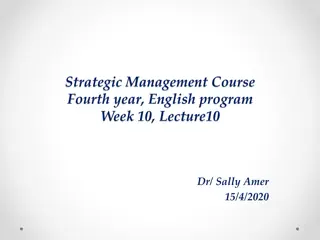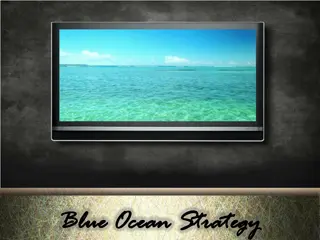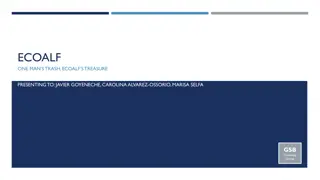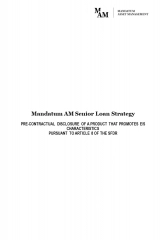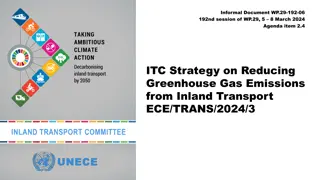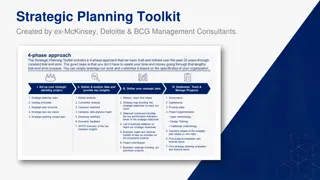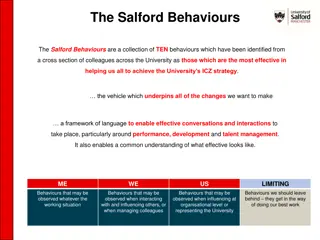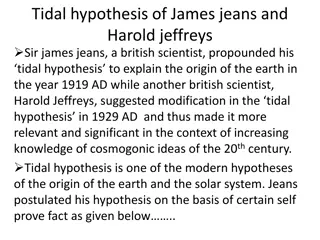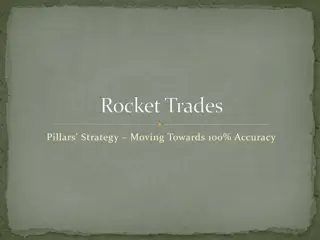Lotus - New Market Strategy by James Gibbins
Lotus, a renowned automotive brand founded in 1948 by Colin Chapman, has a rich history of producing iconic vehicles known for their lightweight and agile performance. Under the ownership of Geely and Etika Automotive, Lotus currently offers a range of products including the Evija hypercar, Emira coupe, Eletre SUV, and upcoming Emeya liftback. With a global presence spanning 46 markets, Lotus faces competition from established players like Tesla, Porsche, BMW, Audi, and Mercedes-Benz as it navigates the evolving landscape of electric vehicles and expands its market reach with a new strategy prepared by James Gibbins.
Download Presentation

Please find below an Image/Link to download the presentation.
The content on the website is provided AS IS for your information and personal use only. It may not be sold, licensed, or shared on other websites without obtaining consent from the author. Download presentation by click this link. If you encounter any issues during the download, it is possible that the publisher has removed the file from their server.
E N D
Presentation Transcript
NEW MARKET STRATEGY Prepared by James Gibbins
Contents About Lotus Lotus' current product offerings Lotus' current markets Competitor analysis BEV market trends Economic outlook Key policies Lotus' new market strategy Select sources 1. 2. 3. 4. 5. 6. 7. 8. 9.
About Lotus Lotus was founded in 1948 in Norfolk, England by Colin Chapman. Chapman s engineering prowess revolutionised motorsport, and his influence continues to be felt to this day. Lotus have manufactured over 20 vehicles in their history, with famous models including the best-selling Elise, used as the base for the Tesla Roadster, and the Esprit, which featured in the James Bond film The Spy Who Loved Me. Within the motoring community, Lotus are famous for designing and building low-weight, agile cars able to outperform their higher-powered but heavier competition. As of September, 2023, Lotus is owned by Geely (51%) and Etika Automotive (49%).
Lotus' current product offerings Lotus currently offers three vehicles, with another coming soon. Evija (2021*): A two-door EV hypercar. Over 2000PS gives incredible power, while adding lightness keeps the Lotus feel. From ~ 2.4m. Main competitor: Rimac Nevera. Emira (2022): A two-door coup . Powered by an I4 or V6, this is likely the last ICE Lotus. Lauded for its grip and handling, like the Evora before it. From ~ 80k. Main competitor: Porsche Cayman. Eletre (2023): A five-door SUV EV. GQ SUV of the Year 2023. Luxury feel, and doesn t feel like a heavy SUV. From ~ 90k. Main competitor: Porsche Cayenne. Emeya (2024): A five-door liftback EV. A true Grand Tourer, combining power, range, and comfort. Expected from ~ 100k. Main competitor: Audi e-tron GT. * The Evija was announced in 2021. As of 2023, first deliveries are due soon.
Lotus' current markets Lotus currently serves 46* markets globally, covering all continents excluding Antarctica. Lotus Centres exist in 39 countries, with Service Centres in 13. Lotus currently primarily serves countries in Central and Western Europe, the Gulf states, East Asia, Australasia, and North America, with selected countries in Central and South America, Southeast Asia, and South Africa. Noticeable gaps in Lotus' market include South Asia, North and Central Africa, most of South America, and Russia. * This number is based on the number of regions the Lotus Cars website is available in, excluding Puerto Rico.
Competitor analysis 1 Current competitors The automotive market is a competitive industry, but the transition to electric vehicles has opened opportunities for new players to leapfrog existing companies and old brands to reimagine themselves and regain their former glory. Simplify, then add lightness Lotus traditionally played in the sports car segment, but have recently expanded into the hypercar and sports SUV segments. Cars by Lotus are differentiative by being fast, fun, and nimble. Lotus' key competitors include Tesla, Porsche, BMW, Audi, and Mercedes-Benz. Tesla is the top-selling EV in most countries in the world. Their Model X SUV, an Eletre competitor, is the top of many best-seller lists, and the Model S, a Emeya competitor, is well-known for it s blend of performance, comfort, and technology. Colin Chapman Porsche were another early mover in the EV space, starting through their motorsport division. They have had significant success with their Taycan saloon/shooting brake EV. The other large German luxury brands (BMW, Audi, and Mercedes-Benz) were slow to transition to EVs, but have recently released some highly acclaimed vehicles, including the iX, e-tron, and EQS.
Competitor analysis 2 Strongest competitor Porsche is Lotus' strongest competitor, and they share many similarities. Both initially focussed on fun, lightweight sports cars before expanding into sporty SUVs and EV hypercars, and both have strong motorsport heritage. Porsche Sales by Region Porsche Sales by Region As of 2023, Porsche only have a single EV, the Taycan. However, soon they will be releasing the Macan SUV EV, which will compete with the Eletre. Approximately 30% of Porsche s car sales were in China, 30% in Europe, 25% in North America, and 15% elsewhere, with the largest year-on-year growth in the elsewhere category. The success Porsche has experienced with the Taycan, released in 2020, demonstrates that the market for sports EVs is high growth yet underserved. This presents a prime opportunity for Lotus to compete, in particular with the soon-to- be-release Emeya. Porsche have benefitted from ownership by VW Group, one of the world s largest auto manufacturers. Under the ownership of Geely, a rapidly-growing Chinese manufacturer, Lotus now has the opportunity to become a star player in the sports EV segment, utilising both the history and values of Lotus and the manufacturing expertise and market strength of China. North America China Europe Elsewhere
Competitor analysis 3 Future competitors A number of marques have a strong presence in the EV segment, but do not currently produce sports vehicles that compete with Lotus. This includes European manufacturers such as VW, Citro n, Peugeot, and koda, and Asian manufacturers such as Hyundai/Kia, MG, Nissan, and BYD. Although these are not currently direct competition, these is a risk that these brands will produce competing vehicles in the future, as markets and technologies improve. For example, brands with a history of producing ICE sports cars, such as the Japanese brands, may move into the EV sports car space (such as a Nissan GT-R EV). Alternatively, the relatively young Chinese brands, who are rapidly gaining expertise and market share, may also move to compete with Lotus, such as Nio sEP9 and BYD s/Yangwang s U9
BEV market trends EV sales are increasing at a rapid rate. Globally, year-on-year growth (2022 H1 to 2023 H1) of 40% has been observed (BEVs and PHEVs), and it is predicted that over 14,000,000 EVs will be sold in 2023 (10,00,000 BEVs and 4,000,000 PHEVs). This is equivalent to approximately 20% of all new car sales in 2023. The biggest market by quantity of EVs sold is China, and the biggest market by percentage of EVs sold as a total of all vehicles sold is Norway. Certain developing countries are experiencing massive growth. EV sales in India, Thailand, and Indonesia more than tripled from 2021 to 2022. Based on projections, by 2050, India is expected to have the largest population and second- largest GDP; Indonesia the 6th by population and 4th by GDP. The largest BEV manufacturer is Tesla and the largest EV (BEV + PHEV) manufacturer is BYD. Geely are 10th by combined total, just behind Mercedes-Benz.
Economic outlook Globally, economies are still struggling. Many developed countries are experiencing under 2% annual GDP growth, and suffering from high level of inflation and cost of living crises. This is reducing disposable incomes, and hence spending on luxury or non-urgent goods. As a consequence, car sales for 2023 are predicted to remain below 2019 levels, although small year-on-year growth has been observed since 2020. However, the number of millionaires in Western and Asian countries has risen dramatically. This customer segment is likely a key one for Lotus, and targeting market growth in countries where this segment is expanding could help the company to avoid experiencing the effects of the economic slowdown.
Key policies Aligned with Net Zero goals, the majority of countries have policies in place supporting EVs. These include subsidies on vehicle purchases, investing in EV infrastructure, and supporting the EV supply chain. Restrictions on traditional vehicles, including Low- Emissions Zones and plans for bans on new ICE vehicle sales, have also been introduced. Notable policies include: China: Several policies focussing on EV manufacturing, including Chongqing aiming to produce 10% of all China s new energy vehicles (NEVs), and Jilin aiming to produce 1,000,000 NEVs annually by 2025. Although the national NEV subsidy scheme has ended, many regional governments have their own schemes. USA: The Inflation Reduction Act (IRA) includes tax incentives and funding programmes for EVs. However, this is focussed on low-cost (<US$55,000 MSRP) EVs assembled in the USA, a market Lotus doesn t currently compete in. The IRA does also support EV chargepoint infrastructure, which will provide a benefit to Lotus. EU: The Green Deal Industry Plan aims to support European manufacturing and adoption of EVs, and includes investing in local resource extraction and processing, battery gigafactories, and EV chargepoint infrastructure. India: The Production Linked Incentives (PLI) targets 50GWh in domestic battery manufacturing capacity. Subsidies and incentives for the purchase on new EVs have been very successful in Europe, as demonstrated by EV market trends. In response, several European countries have reduced or removed these subsidies and incentives, making EVs more expensive to the customer compared with previous years, which may slow uptake.
Lotus' new market strategy Lotus has had an excellent H1 2023, with 17,000 orders globally, and has expanded to 193 retail stores. However, without knowledge of Lotus current per-country sales, it s difficult to design a new market or market growth strategy for the company. Lotus recent re-entry to South Korea seems astute. Korea has a well-developed EV market, and, based on my personal experience living in the country, they prefer imported to domestic cars for luxury and performance models a prime opportunity for Lotus. Additionally, Koreans have an interest in British culture, which could be leveraged, as could the proximity to Chinese manufacturing sites. Opening a Lotus Centre in Seoul would boost brand awareness and help introduce Koreans to the marque. In the medium-term, expansion to Brazil is worth investigating. Brazil is the six-largest car market globally, and EV sales in the country are experiencing ~50% year-on-year growth, although this is still a small percentage of total vehicle sales. It does not have a domestic car marque to compete with, but it is a large auto manufacturing hub, and if Lotus opened operations here it could provide for Lotus existing Argentinian and Chilean markets, as well as those in Central and North America. Since it s 2011 peak, Brazil s economy has been struggling; it currently has a GDP per capita of ~US$9,600 and ~300,000 millionaires. However, the recent change in leadership (back to the pre-2011 Lula), with a new environmental focus, could accelerate the EV transition. Demographic and economic trends suggest India and Indonesia will be important countries within the next 20 years. At present, GDP per capita is ~US$2600 and ~US$5000 respectively; however, the number of millionaires is ~800,000 and ~200,000 respectively, and this is likely grow in the coming decades. Laying the groundwork for this now could prove advantageous in the longer term.
Selected sources https://www.lotuscars.com/ https://en.wikipedia.org/ https://www.howrareismycar.co.uk/ https://www.best-selling-cars.com/ https://www.ev-volumes.com/ https://www.iea.org/ https://data.worldbank.org/ https://www.statista.com/ https://www.ubs.com/ https://uk.motor1.com/






